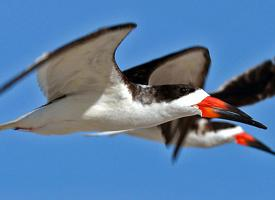
Description de l'animal
The Black Skimmer (Rynchops niger) is a distinctive and fascinating bird species, primarily recognized for its unique foraging method and striking physical appearance. This bird is a member of the skimmer family, which is small and consists of just three species worldwide, each remarkable for their lower mandibles that are longer than the upper ones. The Black Skimmer inhabits the Americas, with its range extending from the northeastern United States down through Central America, to much of South America.Physical Characteristics:
The Black Skimmer stands out visually due to its black and white plumage and its remarkable bill. The upper part of its body is cloaked in a sleek, black color, which contrasts sharply with the white underparts, making it easily recognizable. Its legs are short and red, adding a splash of color to its otherwise monochromatic appearance. The most striking feature of the Black Skimmer, however, is its bill. The bird's orange-red bill is knife-like and uniquely adapted, with the lower mandible significantly longer than the upper one. This adaptation is key to the bird's feeding technique and is not seen in any other bird species.
Size:
Adult Black Skimmers are medium-sized birds, measuring about 40 to 50 cm (16 to 20 inches) in length, with a wingspan of approximately 107 to 127 cm (42 to 50 inches). Their weight varies between 200 to 350 grams (7 to 12 ounces), making them relatively light in comparison to their body size.
Habitat and Distribution:
The Black Skimmer prefers coastal habitats, including sandy or gravelly shores, estuaries, and lagoons. They are often found nesting in colonies on beaches, islands, or saltmarshes, where they can take advantage of the abundant food supply and relatively few land predators. Their distribution is widespread along the Atlantic and Pacific coasts of the Americas, with northern populations migrating southwards during the winter months to avoid the colder temperatures.
Behavior and Diet:
The Black Skimmer is most well-known for its unique foraging behavior. It feeds by flying low over the water with its bill open and the lower mandible slicing through the water. Once the mandible touches a fish, the bird snaps its bill shut, capturing the prey. This method of skimming the water surface allows the Black Skimmer to feed on small fish and crustaceans efficiently, often at dawn or dusk when the water is calmer, and fish are more likely to be near the surface.
Reproduction:
Breeding season for the Black Skimmer occurs during the warmer months. They are colonial nesters, with several pairs often nesting in close proximity to each other. Nests are simple scrapes in the sand or gravel, where the female lays 3 to 5 eggs. Both parents share the responsibility of incubating the eggs for about 23 days until they hatch. The chicks are born with a symmetrical bill, and the lower mandible starts growing longer than the upper one after a few weeks. Parental care is essential during the early stages of the chicks' lives, as they depend on their parents for food and protection.
Conservation Status:
The Black Skimmer is currently listed as Least Concern by the International Union for Conservation of Nature (IUCN), indicating that it is not presently at significant risk of extinction across its range. However, like many coastal species, it faces threats from habitat loss due to human development, pollution, and disturbance at nesting sites. Conservation efforts are crucial to ensure the continued survival of this unique and captivating bird species.
In summary, the Black Skimmer is a remarkable bird, both in appearance and behavior. Its unique feeding strategy, striking coloration, and coastal lifestyle make it an interesting subject of study for ornithologists and a beautiful sight for bird watchers and nature enthusiasts alike.
Nouvelles photos d'animaux
Top 10 des animaux
- Dolphin gull (Leucophaeus scoresbii)
- Japanese macaque (Macaca fuscata)
- Stone loach (Barbatula barbatula)
- Greek tortoise (Testudo graeca)
- Russian tortoise (Testudo horsfieldii)
- Galápagos tortoise (Geochelone nigra complex)
- Diana monkey (Cercopithecus diana)
- Moustached guenon (Cercopithecus cephus)
- Common flying dragon (Draco volans)
- Galápagos penguin (Spheniscus mendiculus)